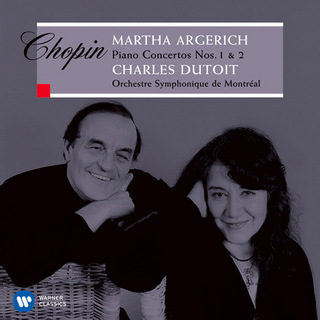
Piano Concertos
Martha Argerich pf Montreal Symphony Orchestra / Charles Dutoit
(Warner Classics)
Martha Argerich’s first commercially released recordings of the Chopin concertos were for DG; No 1 in 1968, No 2 in 1978. Here she revisits both concertos and offers an act of re-creative daring, of an alternating reverie and passion that flashes fire with a thousand different lights. Indeed, her earlier performances are infinitely less witty, personal and eruptive, less inclined to explore, albeit with the most spontaneous caprice and insouciance, so many new facets, angles and possibilities. Now, everything is accomplished without a care for studios and microphones, and with a degree of involvement that suggests an increase rather than a diminution of her love for these works. The recordings are impressively natural and if Dutoit occasionally seems awed if not cowed into anonymity by his soloist (the opening tuttis to the slow movements of both concertos are less memorable than they should be) he sets off Argerich’s charisma to an exceptional degree. Argerich’s light burns brighter than ever. Rarely in their entire history have the Chopin concertos received performances of a more teasing allure, brilliance and idiosyncrasy.
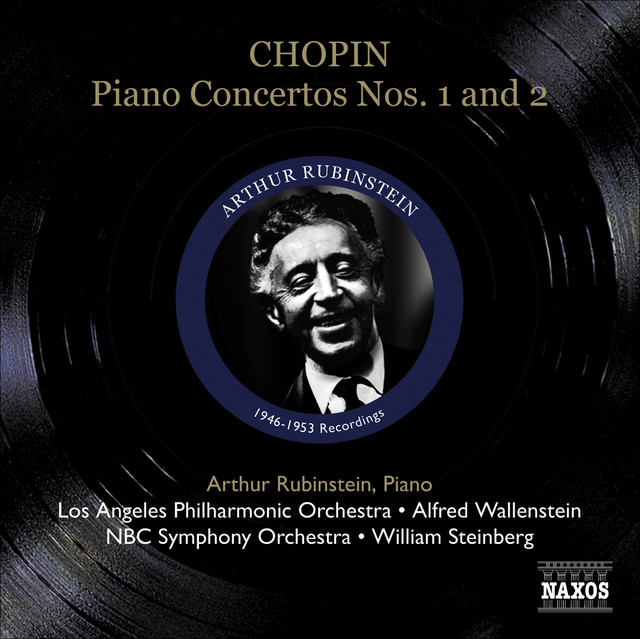
Piano Concertos
Arthur Rubinstein pf Los Angeles Philharmonic Orchestra / Alfred Wallenstein; NBC Symphony Orchestra / William Steinberg
(Naxos Historical mono)
Recorded 1953, 1946
Mercifully uncut, unlike Rubinstein’s previous discs of both concertos with Barbirolli, these are astonishing performances, occasionally, particularly in the Second Concerto, content simply to astonish. Here there is an almost arrogant dismissal of all difficulties and a prima donna stance sometimes hard to square with some of Chopin’s more delicate and ornate confidences. In the scintillating coda Rubinstein takes his bravura to a spine-tingling edge, but in, for example, the Larghetto’s central storms there is a brusque, streamlined indifference to the music’s finer qualities.
In the First Concerto, while recognisably the same pianist, Rubinstein is altogether more subtle, following his characteristic exuberance and extroversion with playing of a rapt magic and delicacy. The music may be sent smartly on its way by both conductor and soloist, but the patrician ease, nonchalant glitter and authority of Rubinstein’s playing are uniquely his to command. These are both extraordinary performances by an extraordinary pianist, though of the two, the First Concerto is the more affecting. Mark Obert-Thorn’s restoration of the 1953 sound is a model of remastery though even he cannot make the 1946 Second Concerto sound less than cramped.
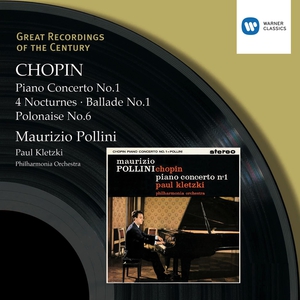
Piano Concerto No 1. Ballade in G minor, Op 23. Nocturnes. Polonaise No 6, ‘Heroic’
Maurizio Pollini pf Philharmonia Orchestra / Paul Kletzki
(Warner Classics)
Recorded 1960, 1968
This disc is a classic. The concerto was recorded shortly after the 18-year-old pianist’s victory at the Warsaw competition in 1959. Nowadays we might expect a wider dynamic range to allow greater power in the first movement’s tuttis but in all other respects the recording completely belies its age, with a near-perfect balance between soloist and orchestra. This is very much Pollini’s disc, just as the First Concerto is very much the soloist’s show, but effacing as the accompaniment is, Pollini’s keyboard miracles of poetry and refinement could not have been achieved without one of the most characterful and responsive accounts of that accompaniment ever committed to tape. The expressive range of the Philharmonia on top form under Kletzki is exceptional, as is the accord between soloist and conductor in phrasing and shading. The solo items are a further reminder of Pollini’s effortless bravura and aristocratic poise.
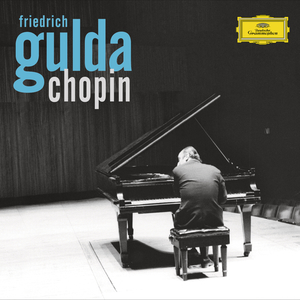
Piano Concerto No 1. Four Ballades. Barcarolle. Nocturnes. Preludes. Waltz No 14
Friedrich Gulda pf London Philharmonic Orchestra / Sir Adrian Boult
(DG)
Here in all his glory is Friedrich Gulda the ultimate maverick pianist, yet beneath his determined assault on what he saw as the stuffy conventions of the music world (the Viennese world in particular) lay a pianist of genius aptly described by Martha Argerich, his one-time protégée, as ‘the most extraordinary and brilliant man I ever met’.
Certainly all the live performances on these discs create a towering tribute to Chopin. Forever the nonconformist, Gulda may sometimes be wilful and irascible but he is never less than mesmeric and fascinating. Time and again he casts a novel and intense light on even the most familiar phrase, making you hang on every note. Try Prelude No 14 for a virtuoso savagery beyond the world of other more ‘civilised’ pianists, or No 13 where Gulda’s rapture makes the music stretch seemingly to infinity. Again there may be moments in the Ballades and Barcarolle where the playing verges on hysteria but the sheer mastery and strength are like an elemental force of nature. Even when he takes a rough hand to some of Chopin’s more intimate confessions, his way with his selection of Nocturnes creates a sense of drama and occasion light years away from more recent recordings.
The First Concerto is given in Balakirev’s touched-up version and if in the studio Gulda’s playing is more disciplined, less free-thinking, it is also of a special imaginative delicacy and engagement. The programme ends with Gulda’s own Epitaph for a Love, a strange mixed-up jazz effusion that includes some very odd vocals in Viennese dialect and a phantom reference to Chopin’s C minor Prelude. The pianist’s son, Paul Gulda, writes a moving and informative essay clarifying much of his father’s complexity and telling us, perhaps not surprisingly, that Alfred Cortot was among his chief musical idols.
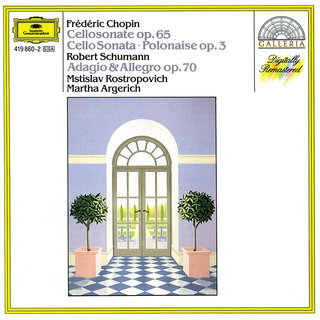
Cello Sonata. Introduction and Polonaise brillante in C
Mstislav Rostropovich vc Martha Argerich pf
(DG)
The recording by Paul Tortelier and Aldo Ciccolini of the last work Chopin published (Paris, 1847), which they couple with Rachmaninov's Sonata, has been a favourite of mine since it appeared. But I am at last almost persuaded that it has been supplanted. In fact, both that performance and this one by Mstislav Rostropovich and Martha Argerich are of strongly marked character, acutely, though differently, responsive to the music's every inflection, and both provide deep satisfactions. The Tortelier recording is somewhat warmer, the separation between the instruments better defined; yet this recording is excellent also.
A lesser known Chopin work for cello and piano is the Introduction and Polonaise brillante, Op 3 (though it is not so little known as his Grand Duo on themes from Meyerbeer's Robert Ie Diable). He wrote the Polonaise in October 1829, adding a touching Introduction the following July. This new performance is easily the best I have ever heard and one particularly enjoys the counterpoint of slow cello and fast piano, of ardent lyricism and exuberant virtuosity. This is altogether a recording of magnificent playing.
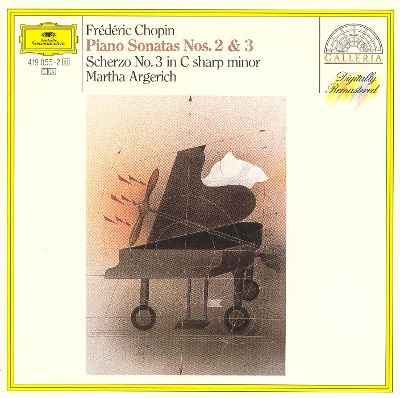
Piano Sonatas Nos 2 & 3. Scherzo No 3
Martha Argerich pf
(DG)
Recorded 1975, 1967, 1961
Here, simply and assuredly, is one of the most magisterial talents in the entire history of piano playing. She’s hardly a comfortable companion, confirming your preconceptions. Indeed, she sets your heart and mind reeling so that you positively cry out for respite from her dazzling and super-sensitive enquiry. But she’s surely a great musician first and a great pianist second. From her, Chopin is hardly the most balanced or classically biased of the Romantics. She can tear all complacency aside. How she keeps you on the qui vive in the Second and Third Sonatas. Is the Funeral March too brisk, an expression of sadness for the death of a distant relative rather than grief for a nation? Is the delicate rhythmic play at the heart of the Third Sonata’s Scherzo virtually spun out of existence? Such qualms or queries tend to be whirled into extinction by more significant felicities. Who but Argerich, with her subtle half-pedalling, could conjure so baleful and macabre a picture of ‘winds whistling over graveyards’ in the Second Sonata’s finale, or achieve such heart-stopping exultance in the final pages of the Third Sonata (this performance is early Argerich with a vengeance, alive with a nervous brio). And if her free spirit leaves us tantalised, thirsting for Chopin’s First, Second and Fourth Scherzos as well as his Third, for example, she has also left us overwhelmingly enriched, forever in her debt.
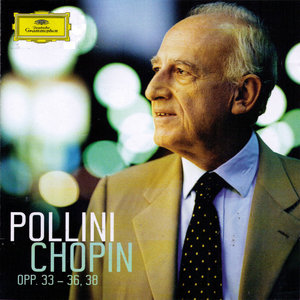
Piano Sonata No 2. Ballade No 2. Mazurkas Nos 22-25. Waltzes Nos 2-4. Impromptu No 2
Maurizio Pollini pf
(DG)
The programme embraces Chopin’s Opp 33‑38 with the exception of the two Nocturnes, Op 37, though they’re not played in chronological order. Pollini begins with a magnificent account of the Ballade No 2, the maelstrom that erupts after the pastoral first page sounding like a howl of despair. The four Mazurkas, Op 33, and three Waltzes, Op 34, not only form a contrast to the Ballade but are themselves contrasted with each other. The F sharp major Impromptu, almost a mini-ballade, is heard in another refined account, Pollini relishing the leggiero jeu perlé scale passagework at the close. In the Second Sonata, Pollini unites what Schumann called ‘four of [Chopin’s] wildest children’ into a family, a feat managed by few pianists, the first movement (with a da capo repeat) leading quite naturally into the Scherzo and so on.
It’d be difficult for Pollini to produce an ugly sound (and he doesn’t here), but while the piano is captured from a slight distance (say the front row of the stalls), the pianist’s frequent nasal intakes of breath are recorded in close-up.
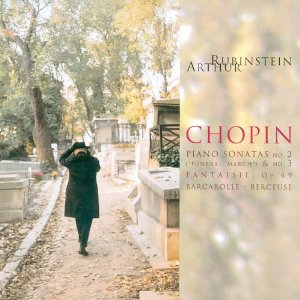
Piano Sonatas Nos 2 & 3. Fantasie, Op 49
Arthur Rubinstein pf
(RCA Victor Red Seal)
In the Chopin sonatas it’s difficult to think of which performance to choose as the greatest. Aside from the Funeral March itself, Rubinstein’s account of the Second Sonata is a bit too imperious; the Third is much more thrilling, with considerable technical risks being taken both in the first movement and the finale. His own feeling for quiet nuances in the Largo of this work is quite superb, and here too Pollini on DG achieves an innocence that’s disarming. Pollini’s disc is the most perfect, both in terms of the pianist’s technical accomplishment and the lucid piano sound, with nothing that offends the ear. The middle treble range in Rubinstein’s piano sound has a hollow resonance. Rubinstein tackles the F minor Fantasie in rather a heavy-handed manner, with more power than searching drama. If you want your Chopin sonatas balanced and formally cohesive, then Rubinstein is for you.
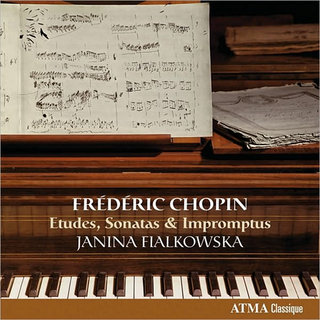
Piano Sonatas Nos 2 & 3. Etudes. Impromptus Nos 1-3. Fantaisie-impromptu
Janina Fialkowska pf
(ATMA Classique)
Lesser mortals may well weep with envy at such unfaltering authority and one hesitates even to imagine the hours of work behind such magnificence. What a glittering and assured curtain-raiser to the Op 10 Etudes; and if she can command with the best of them she can just as easily take you into her confidence. No 3 is, for once, truly Lento though with a marked sense of character in the central Poco più animato, while in No 6 Fialkowska is hauntingly responsive to Chopin’s nameless malaise. How perfectly she judges the echoing mountain-calls in No 9, while even the most seasoned pianist might despair over her fleetness in the Op 25 Etude ‘in thirds’.
Elsewhere she is grand and imperious in the Second Sonata, storming the first movement’s climax in towering and heroic fashion, and her demonic pace and drive make a true Mephisto-scherzo of the second movement. Her finale, while hardly sotto voce, opts for a more ferocious but intriguingly voiced alternative and she has all of the four Impromptus’ lighter charm and caprice at her fingertips. Her B minor Sonata is as thoughtful as it is masterly and if one occasionally misses the seductive tonal allure and magical cantabile of a Cortot or Perahia (most notably in the Largo), there’s admiration aplenty for such clarity, strength of purpose and musical integrity. Fialkowska offers an unfailing balance of sense and sensibility. Well recorded, she has done her one-time mentor, Arthur Rubinstein, proud.

Piano Sonata No 3. Mazurkas Nos 36-38. Nocturne No 4. Polonaise No 6. Scherzo No 3
Martha Argerich pf
(Warner Classics)
Argerich’s pianism is remarkable for combining seemingly effortless technical resource with temperamental volatility. Yet the vehemence of her playing is seldom to the disadvantage of the extraordinary subtlety of her art. Moreover, despite the limits she places on her repertory, such is the spontaneity of her approach that each of her interpretations, no matter how familiar in broad outline, is characterised by a profusion of contrasting details beneath the surface. In the B minor Sonata she omits the first-movement repeats. Such a formal contraction can contribute to the momentum with which the movement unfolds. Ironically, however, she seems to rein in the propulsive power for which she’s renowned, appearing instead to be seeking at every turn to exploit a deeply felt exprssive lyricism to offset the febrile intensity of the most energetic figurational devices. This has the virtue of allowing us a less hectic view of subsidiary elements within the music, which elsewhere can too often be overwhelmed by the sheer turbulence of the action. Some of the most satisfying playing on the disc comes in her account of the Op 59 Mazurkas. There’s a vulnerability as well as an affecting wistfulness about the playing which captures the elusiveness of the idiom, with its harmonic ambiguities, with rare acuity. At the other end of the scale, the excitement she generates in the A flat Polonaise is of an order that goes far beyond mere effect. If these accounts do not necessarily outstrip her other recordings, they nevertheless offer an intriguing insight into a ‘work in progress’ from a pianistic giant whose artistry continues to fascinate and perplex.
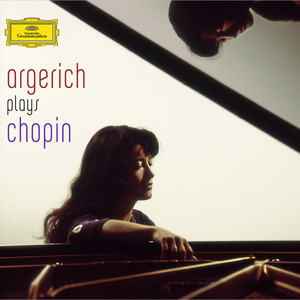
Piano Sonata No 3. Ballade No 1. Etudes. Mazurkas. Nocturnes
Martha Argerich pf
(DG)
Argerich first came to international prominence in 1965 when she won the Chopin Competition. The first track on this CD dates from six years earlier, a blistering performance of the G minor Ballade recently unearthed in the archives of Deutschlandradio Kultur (formerly RIAS) in Berlin. The work is new to Argerich’s discography but, though it will not worry her legions of admirers, neither the recorded sound nor the duff piano are things of aural beauty.
There is a marked improvement in these respects in the following selections of Mazurkas and Nocturnes recorded in a different RIAS studio eight years later with, inevitably, a greater depth and maturity to the playing. Before these, there is a quite dazzling performance of the Op 10 C sharp minor Etude, not the fastest on disc (though fairly brisk) but one of the fastest that also makes musical sense. This and the Mazurkas Op 24 No 2, Op 33 No 2 and Op 41 Nos 1 and 4 are also works Argerich has not otherwise recorded. From the playing here, it’s no wonder she won the Chopin Competition. Likewise in the three Mazurkas Op 59, discovered in the vaults of West German Radio (WDR) in Cologne, she captures their intimacy and lightning changes of mood to perfection.
Then the B minor Sonata, a live performance at the Berlin Hochschule für Musik. Though she over-reaches herself in the first part of the Scherzo, this is even better than her familiar studio recording of two months earlier. In the finale (for once truly agitato) she sweeps all before her with breathless exhilaration.
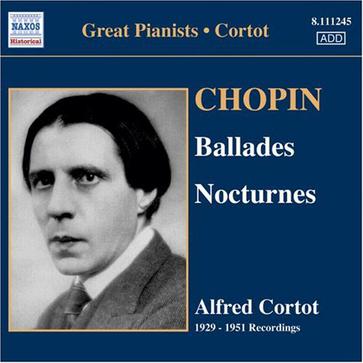
Four Ballades. Nocturnes
Alfred Cortot pf
(Naxos Historical mono)
From HMV originals, recorded 1929-51
This fifth and final release of Cortot’s 78rpm Chopin recordings is surely the jewel in the crown. Here, the 1929 rather than the more familiar 1933 set of the Ballades blazes with a passion, brilliance and poetic audacity that set the pulse racing and the mind reeling. Here is a great artist who seized the opportunity to achieve ever greater heights of eloquence and rhetorical verve. Superbly restored by Mark Obert-Thorn, every performance is charged with a heady and consuming poetry that confirms Daniel Barenboim’s claim that ‘Cortot discovered the opium in Chopin’. Take the First Ballade’s opening, where Cortot is every inch the bardic poet, free, rhapsodic and inimitable; or hear him in the Presto con fuoco storms of the Second Ballade, where he plays as if pursued by the furies of hell.
Again, even when inaccuracies fly in all directions in the heat of the chase, no other pianist has approached the Third Ballade’s central C sharp minor turbulence with such daring or recreative force. Cortot was never one to hold back in the interests of decorum and in the Fourth Ballade he stretches the parameters of Chopin’s poetry to the very edge, his playing close to being consumed in its own ecstasy.
His selection of Nocturnes (sadly his projected Chopin survey was never completed) pulse with the same alluring quality, suggesting the reverse of Rubinstein’s more patrician elegance. True, for today’s more antiseptic and ‘tasteful’ practitioners such artistic conviction and originality will seem extravagant or even camp. Yet there is surely no living pianist who could or would attempt to emulate such heart-stopping poetry. Maria Callas herself would have been among the first to pay tribute to Cortot’s cantabile, an unequalled ‘singing’ at the piano.
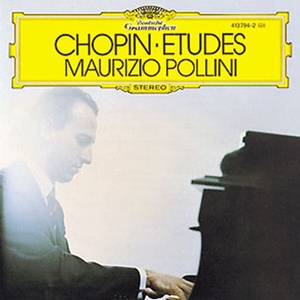
Etudes
Maurizio Pollini pf
(DG)
Recorded 1972
The 24 Etudes of Chopin’s Opp 10 and 25, although dating from his twenties, remain among the most perfect specimens of the genre ever known, with all technical challenges – and they are formidable – dissolved into the purest poetry. With his own transcendental technique (and there are few living pianists who can rival it), Pollini makes you unaware that problems even exist – as for instance in Op 10 No 10 in A flat, where the listener is swept along in an effortless stream of melody. The first and last of the same set in C major and C minor have an imperious strength and drive; likewise the last three impassioned outpourings of Op 25.
Lifelong dislike of a heart worn on the sleeve makes him less than intimately confiding in more personal contexts such as No 3 in E major and No 6 in E flat minor from Op 10, or the nostalgic middle section of No 5 in E minor and the searing No 7 in C sharp minor from Op 25. Like the playing, so the recording itself could profitably be a little warmer at times, but it’s a princely disc all the same.
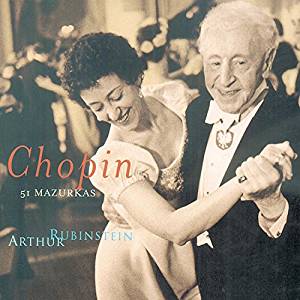
Mazurkas Nos 1-51
Arthur Rubinstein pf
(RCA Victor Red Seal)
Recorded in the 1960s
Recording in the studio, rather than at a live concert, quite naturally leads to a safe and uniform approach, which doesn’t really serve the inspired inventiveness of the music. In some ways these recordings suffer from this. If you compare Rubinstein’s readings here with those he recorded on 78rpm discs in 1938-39, you immediately notice that an element of fantasy and caprice has given way to a more sober view of the music. The Mazurkas are so intricate in their variety of moods that the successful pianist has to be able to treat each one as an entity, contrasting the emotional content within the context of that particular piece. Rubinstein, with his serious approach, lends the music more weight than is usual and he wholly avoids trivialising it with over-snappy rhythms. With him many of the lesser-known Mazurkas come to life, such as the E flat minor, Op 6 No 4, with its insistent little motif that pervades the whole piece. His phrasing is free and flexible and he has utter appreciation of the delicacy of Chopin’s ideas. He doesn’t, however, take an improvisatory approach. Rubinstein judges to perfection which details to bring out so as to give each piece a special character. He convinces one that he has made this music his own. When you hear Rubinstein tackle the C sharp minor Mazurka, Op 53 No 3, you at once know that he fully comprehends the depth of this, perhaps the greatest of them all. He ranges from the pathos of the opening to a persuasive tonal grandeur in the more assertive parts, and yet is able to relate the two. The recording has a number of blemishes: the piano is too closely recorded, the loud passages are hollow-toned, especially in the bass, and there is little sparkle to the sound.
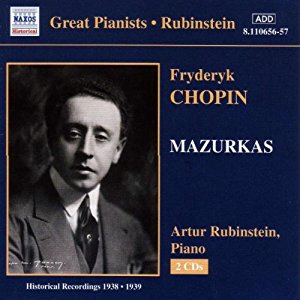
Mazurkas Nos 1-51. Waltzes
Arthur Rubinstein pf
(Naxos Historical mono – 8 110656/7)
Nocturnes, Nos 1-19. Four Scherzos
Arthur Rubinstein pf
(Naxos Historical mono – 8 110659/60)
It’s controversial to say so, but such playing makes a mockery of present-day standards. All these performances prove that Rubinstein played the piano as naturally as a bird flies or a fish swims. He was simply in his element, and never more so than in Chopin. Who else has given us the Nocturnes with such ravishing inwardness, pianistic sheen and a bel canto to rival the finest singer? Decorative fioritureare spun off like so much silk, and whether or not you consider Op 15 No 2 ‘inseparable from champagne and truffles’ and Op 27 No 1 a portrait of ‘a corpse washed ashore on a Venetian lagoon’, or hear the nightingales of Nohant in Op 62 No 1 and the chant of the monks of Valdemosa in Op 15 No 3 and Op 37 No 1, you can hardly remain unaffected by Rubinstein’s unique artistry. His feline ease in the double-note flow of Op 37 No 2, or the way he lightens the darkness of the great C minor Nocturne without losing an ounce of its tragedy, all form part of the genius that made him the most celebrated of all Chopin pianists.
Rubinstein’s Mazurkas are equally the stuff of legends. Chopin’s most subtle and confessional diary, they transcend their humble origins and become in Rubinstein’s hands an ever-audacious series of miniatures extending from the neurasthenic to the radiant, from Chopin’s nagging child (Op 17 No 3) to the unfurling of proud ceremonial colours (Opp 63 No 1). What heartache he conveys in Op 63 No 3; and when has Op 67 No 3 been more intimately confided, its banal association with Les sylphides more blissfully resolved? Chopin’s final composition, Op 68 No 4, becomes a valediction encouraging rather than forbidding weeping, Rubinstein’s rubato the caressing magic that created a furore at his unforgettable recitals.
Finally the Scherzos, played with an outrageous but enthralling disregard for safety. Only a pedant will underline the odd mis-hit or pock-mark in the context of such sky-rocketing bravura and poetic impulse. As an added bonus there are additional recordings of three Mazurkas and two Waltzes, the A flat Op 34 No 1 alive with dizzying virtuoso trickery. The booklet-note writer may comically mistake the Mazurkas for the Polonaises in referring to Schumann’s oft-misquoted description, ‘guns [sic] buried in flowers’, but that’s a mere spot on Naxos’s blazing sun. No more life-affirming Chopin exists.
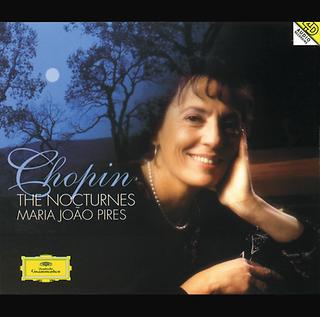
Nocturnes
Maria João Pires pf
(DG)
Passion rather than insouciance is Pires’s keynote. Here is an intensity and drama that scorn all complacent salon or drawing-room expectations. How she relishes Chopin’s central storms, creating a vivid and spectacular yet unhistrionic contrast with all surrounding serenity or ‘embalmed darkness’. The con fuoco of Op 15 No 1 erupts in a fine fury and in the first Nocturne, Op 9 No 1, Pires’s sharp observance of Chopin’s appassionato marking comes like a prophecy of the coda’s sudden blaze. Chopin, she informs us in no uncertain terms, was no sentimentalist. More intimately, in Op 15 No 3 (where the music’s wavering sense of irresolution led to the sobriquet ‘the Hamlet Nocturne’) Pires makes you hang on to every note in the coda’s curious, echoing chimes, and in the dolcissimo conclusion to No 8 (Op 27 No 2) there’s an unforgettable sense of ‘all passion spent’, of gradually ebbing emotion. Pires with her burning clarity has reinforced our sense of Chopin’s stature and created a new range of possibilities (showing us that there’s life after Rubinstein). Naturally, Rubinstein’s legendary cycles possess a graciousness, an ease and elegance reflecting, perhaps, a long-vanished Belle Epoque. Yet moving ahead, one has no hesitation in declaring Maria João Pires among the most eloquent master-musicians of our time.
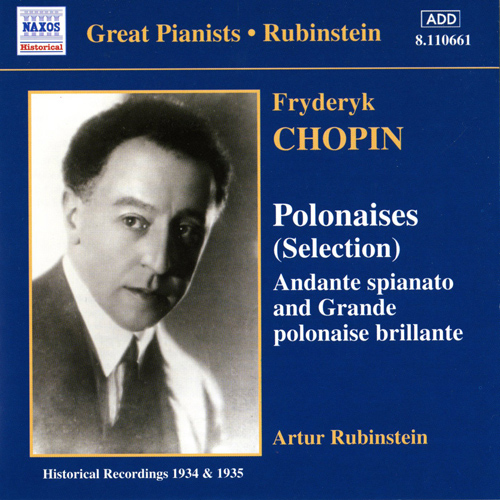
Polonaises Nos 1-7. Andante spianato and Grande polonaise, Op 22
Arthur Rubinstein pf
(Naxos Historical mono)
Recorded 1934-35
Here, in all their glory, are Rubinstein’s 1934-35 recordings of Chopin’s six mature Polonaises framed by examples of his early and late genius (Opp 22 and 61 respectively). Together with his early discs of the Mazurkas, Scherzos and Nocturnes, these performances remain classics of an unassailable calibre, their richness and character increased rather than diminished by the passage of time.
For Schumann, the Polonaises were ‘cannons buried in flowers’ and whether epic or confiding, stark or florid, their national and personal fervour is realised to perfection by Rubinstein. Listen to the Andante spianato from Op 22 and you’ll hear a matchless cantabile, a tribute to a bel canto so often at the heart of Chopin’s elusive and heroic genius. Try the central meno mosso from the First Polonaise and witness an imaginative freedom that can make all possible rivals sound stiff and ungainly by comparison. The colours of the A major Polonaise are unfurled with a rare sense of its ceremonial nature, and the darker, indeed tragic, character of its sombre C minor companion is no less surely caught. The two ‘big’ Polonaises, Opp 44 and 53, are offered with a fearless bravura (you can almost hear the audience’s uproar after Rubinstein’s thunderous conclusion to the latter), rhythmic impetus and idiomatic command beyond criticism.
The simple truth is that Rubinstein played the piano as a fish swims in water, free to phrase and inflect with a magic peculiarly his own, to make, in Liszt’s words, ‘emotion speak, weep and sing and sigh’. The sound may seem dated but Naxos’s transfers are excellent, and to think that all this is offered at super-budget price…
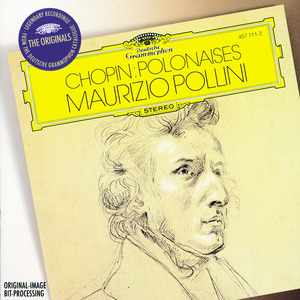
Polonaises Nos 1-7
Maurizio Pollini pf
(DG)
Recorded 1975
This is Pollini in all his early glory, in expertly transferred performances. Shorn of all virtuoso compromise or indulgence, the majestic force of his command is indissolubly integrated with the seriousness of his heroic impulse. Rarely will you be compelled into such awareness of the underlying malaise beneath the outward and nationalist defiance of the Polonaises. The tension and menace at the start of No 2 are almost palpable, its storming and disconsolate continuation made a true mirror of Poland’s clouded history. The C minor Polonaise’s denouement, too, emerges with a chilling sense of finality, and Pollini’s way with the pounding audacity commencing at 3'00" in the epic F sharp minor Polonaise is like some ruthless prophecy of every percussive, anti-lyrical gesture to come. At 7'59" Chopin’s flame-throwing interjections are volcanic, and if there’s ample poetic delicacy and compensation (notably in the Polonaise-fantaisie, always among Chopin’s most profoundly speculative masterpieces), it’s the more elemental side of his genius, his ‘cannons’ rather than ‘flowers’ that are made to sear and haunt the memory. Other pianists may be more outwardly beguiling, but Pollini’s magnificently unsettling Chopin can be as imperious and unarguable as any on record. That his performances are also deeply moving is a tribute to his unique status.
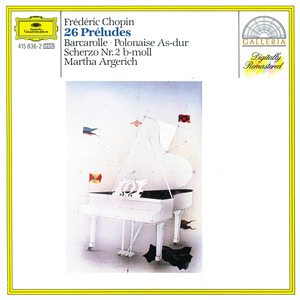
Preludes Nos 1-26. Barcarolle, Op 60. Polonaise No 6. Scherzo No 2
Martha Argerich pf
(DG)
Jerzy Żurawlew, the founder of the Chopin Competition in Warsaw, was once asked which one of the prize-winners he would pick as having been his favourite. The answer came back immediately: Martha Argerich. This disc could explain why. There are very few recordings of the 24 Preludes that have such a perfect combination of temperamental virtuosity and compelling artistic insight. Argerich has the technical equipment to do whatever she wishes with the music. Whether it’s in the haunting, dark melancholy of No 2 in A minor or the lightning turmoil of No 16 in B flat minor, she’s profoundly impressive. It’s these sharp changes of mood that make her performance scintillatingly unpredictable. In the Barcarolle there’s no relaxed base on which the melodies of the right hand are constructed, as is conventional, but more the piece emerges as a stormy odyssey through life, with moments of visionary awareness. Argerich is on firmer ground in the Polonaise, where her power and technical security reign triumphant. The CD ends with a rippling and yet slightly aggressive reading of the Second Scherzo. This is very much the playing of a pianist who lives in the ‘fast lane’ of life. The sound quality is a bit reverberant, an effect heightened by the fact that Argerich has a tendency to overpedal.
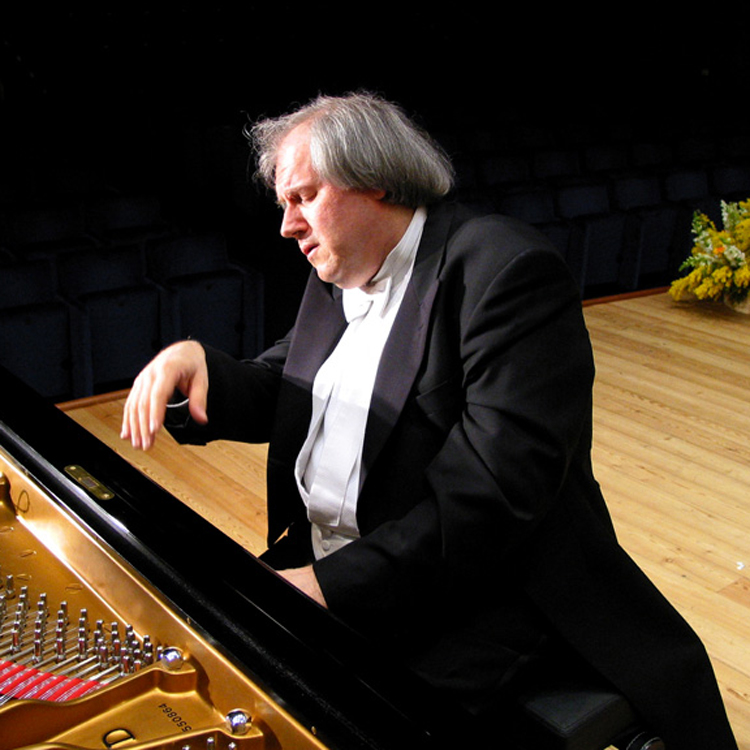
Preludes. Mazurkas Nos 41 & 47
Grigory Sokolov pf
(DG)
Good news for pianophiles everywhere that Grigory Sokolov has, as DG put it, now signed an exclusive contract. This is of course not taking him into the studio or anything as workaday as that. No, he has allowed them to release a live recital from the 2008 Salzburg Festival. But let’s not knock that: it’s difficult to imagine just how much negotiation that must have taken. Comparisons are irrelevant (except perhaps with himself): this is Sokolov we’re talking about. But in this cult of celebrity, his very aversion to the notion has turned him into one – a bit like Glenn Gould in an earlier era.
Of course, all of this would be beside the point if he didn’t produce the goods. It’s an overused word, but he is inimitable. His Chopin Preludes, for example, have no time for the notion of a freely Romantic melodic line being kept in check by a Classical accompaniment. Sokolov’s reading as a whole is remarkably consistent with that of his live 1990 recital released on Opus 111. In both, he begins unhurriedly, as if the music were gently rousing itself into life. But whereas in less imaginative hands the results could seem mannered or overly drawn out, here it’s mesmerising. In the Sixth Prelude, for instance, the upward curling arpeggio has a rare poignancy, while the Tenth glistens but also has an unexpected hesitancy about it. In No 13, the glorious melody of the middle section is given with a freedom that would simply not work in a lesser musician; while in the infamous ‘Raindrop’, Sokolov replaces the constant dripping with a shifting pulse that has a real urgency, albeit an unconventional one. No 19 is a particular highlight, its delicacy quite heart-stopping. He ends as he began, with a tempo for No 24 that has gravitas (not to be confused with heaviness), the effect granitic, magisterial.
The Mozart is treasurable too, though – of course – you have to take it on its own terms. What he does with the slow movement of K280, for instance, gives it a kind of operatic reach and breadth, though never does it lapse into histrionics. And in the finale he brings out the main theme’s stuttering quality superbly, lending the music not just a mercurial quality but a dramatic one too. His delight in the chewy harmonies of the opening movement of K332 is palpable, his phrasing iridescent in its range.
The Salzburg audience (who are generally reasonably silent except for the tumultuous applause) were lucky enough to get six encores. The Scriabin Poèmes are more than usually clear descendants of Chopin in Sokolov’s hands and the filigree is out of this world. By contrast, Rameau’s Les Sauvages is unexpectedly playful and whimsical, and we end with a clear-sighted Bach chorale prelude that is all the more moving for its apparent simplicity. As Sokolov says in the booklet: ‘I play only what I want to play at the current moment.’ Perhaps that’s what gives this set such integrity.
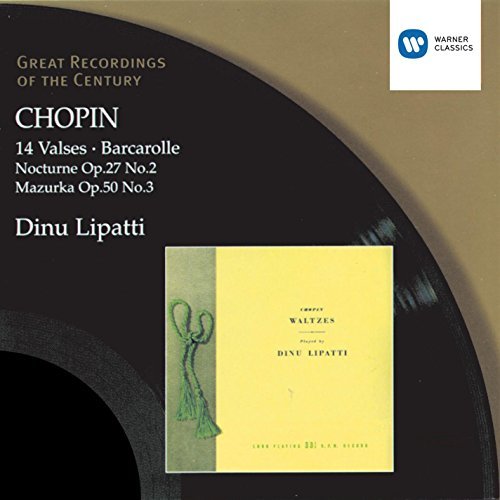
Waltzes Nos 1-14. Mazurka No 32. Barcarolle, Op 60. Nocturne in D flat
Dinu Lipatti pf
(Warner Classics)
Recorded 1947-50
As a former pupil of Cortot, it wasn’t perhaps surprising that Lipatti always kept a special place in his heart for Chopin. And thanks primarily to the 14 Waltzes, played in a non-chronological sequence of his own choosing, it’s doubtful if the disc will ever find itself long absent from the catalogue. Like the solitary Mazurka, they were recorded in Geneva during his remarkable renewal of strength in the summer of 1950. The Nocturne and Barcarolle date back to visits to EMI’s Abbey Road studio in 1947 and 1948 respectively. Just once or twice in the Waltzes you might feel tempted to question his sharp tempo changes for mood contrast within one and the same piece – as for instance in No 9 in A flat, Op 69 No 1. However, for the most part his mercurial lightness, fleetness and charm are pure delight. His Nocturnein D flat has long been hailed as one of the finest versions currently available. And even though we know he himself (one of the greatest perfectionists) was not completely happy about the Barcarolle, for the rest of us this glowing performance has a strength of direction and shapeliness all its own. In fuller contexts there’s just a trace of plumminess in the recorded sound.
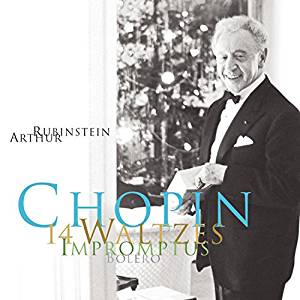
Waltzes Nos 1-14
Arthur Rubinstein pf
(RCA Red Seal)
Recorded 1960s
There has in recent years been a tendency to take Rubinstein’s imposing series of Chopin recordings from the mid-1960s for granted, but to hear them digitally refurbished soon puts a stop to that. His tone doesn’t have much luxuriance, being quite chiselled; yet a finely tuned sensibility is evident throughout. This is at once demonstrated by his direct interpretation of Op 18, its elegance explicit. His reading of Op 34 No 1 is brillante, as per Chopin’s title. In Op 34 No 2 Rubinstein judges everything faultlessly, distilling the sorrowful yet cannily varied grace of this piece. The two finest here are Opp 42 and 64 No 2, and with the former Rubinstein excels in the unification of its diverse elements, its rises and falls of intensity, its hurryings forward and holdings back. This is also true of his reading of Op 64 No 2, the yearning of whose brief più lento section is memorable indeed. The sole fault of this issue is that conventional programming leads to the mature Waltzes, which were published by Chopin himself, coming first, the lesser, posthumously printed items last. Not all of these are early but they have less substance than Opp 18-64, and should come first.
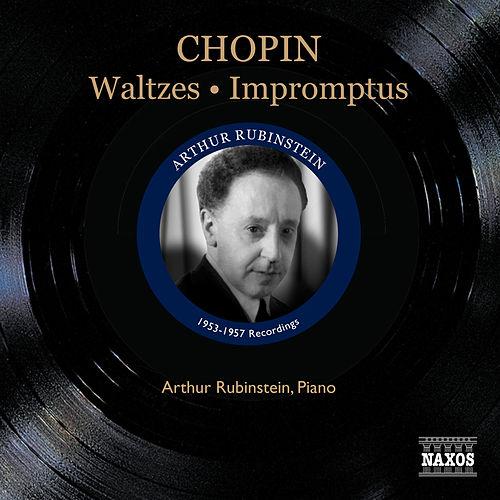
Waltzes Nos 1-14. Impromptus – Nos 1-3. Fantaisie-impromptu
Arthur Rubinstein pf
(Naxos)
Recorded 1953-57
This invaluable issue of recordings dating from the 1950s does yet more to Rubinstein’s status as the greatest of all Chopin pianists. Outwardly sober-suited and without the occasional wildnesses or mischievous emendations of the score that so delighted his capacity audiences, his relative reserve thinly disguises a heart of gold. Try Waltzes Nos 3, 7 and 13, where Rubinstein emphasises a melancholy and introspection far removed from the ballroom glitter of the more extrovert numbers, and you will realise that no other pianist has captured more subtly Chopin’s unique blend of classical bias and romantic freedom. Here in particular you note an elegance and insinuation devoid of all sentimentality, neurosis or self-serving idiosyncrasy.
Such quality is even more pronounced in the Impromptus, where Rubinstein’s musical breathing plays across the music’s surface like some gentle but enticing balm. His way with the bardic Second Impromptu is a poetic ultimate; here the Chopin of our dreams becomes a reality. There is not a single contemporary pianist who comes within distance of such playing. The Hollywood-based recordings are tight and dry.



No hay comentarios:
Publicar un comentario